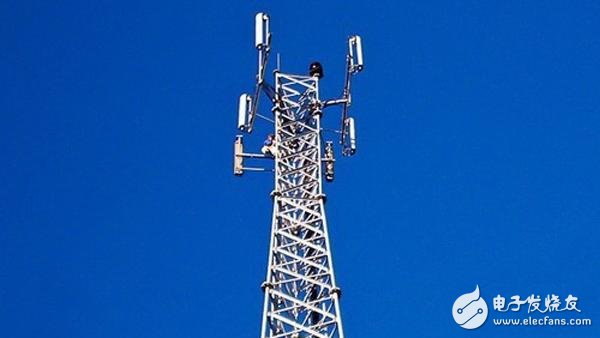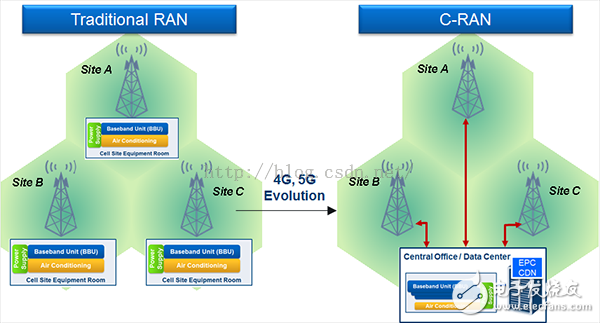Recently, there has been a lot of talks in the industry media about mobile network operators (such as Verizon Wireless and AT&T in the US, France Telecom and China Mobile, etc.) to explore a new network architecture called C-RAN (or centralized radio access network). Report.
All mobile business users should be concerned about C-RAN. Why? Here are five reasons.

Before stating these reasons, let's quickly summarize the C-RAN technology. Every reader has undoubtedly seen the base station tower, and the antenna on it is a specific company that sends and receives information to customers in the area served by the tower. The bottom of the base station tower is a relatively small building, a bit like a small shed with a lot of equipment inside, including:
Mobile processing device (ie base unit)
"Transport" device used to connect the base station to the rest of the mobile operator's network
Air conditioning equipment to control the temperature of the equipment within its normal operating range
A power source used to power the transmitters on the tower and the above devices.
This is the so-called "traditional architecture." In the new C-RAN architecture, there are no more devices at each base station. Instead, these devices are concentrated somewhere nearby (headquarters or data center), where devices with multiple base stations for a particular area are also installed - so the "C" in the C-RAN means Centralized.

Now, come back and see what these changes mean for us and list the five reasons why you should be concerned about this (in any order):
Reason One: Improving the Environment As the mobile user base grows larger, more base station towers are needed to provide increasing connection speeds, and the greenhouse gas emissions from mobile communication networks are also increasing significantly. Ericsson expects that by 2020, the global mobile communications industry will release 0.5% of the world's total greenhouse gas (GHG) – a significant increase from 0.2% in 2007.
Don't misunderstand, in fact, this number is already very good. Mobile operators are classified as “mild†in terms of environmental impact, but this figure still means 178 Mton of CO2.
How does C-RAN improve environmental impact? Take China Mobile, the world's largest mobile network operator, as an example. In its white paper on C-RAN, 72% of energy consumption is consumed at the base station, of which air conditioning accounts for an astonishing 46%!
If all existing and future base stations are (miraculously) evolving into a C-RAN model and utilizing the existing air conditioning equipment in the existing headquarters, the 2020 air will reduce CO 2 by 59 M tons. This is just the number in 2020 - imagine the 2030 scene...
Since it is obviously not feasible to change all existing base stations to C-RAN, can all new base stations be designed as C-RAN? Considering that only about a million new base stations will be built in China in 2015, this consideration is still very meaningful.
Not only that, most mobile operators will actively perform maintenance on each base station on a regular basis, which is called “home service†and focuses on devices in the equipment room. With C-RAN, you can expect that in the future, operators will no longer need to drive to thousands of base stations every month, and the emissions of cars will naturally be greatly reduced.
Reason 2: The download speed is faster In order to achieve the user's required connection speed increase (I upgraded from Blackberry to the new Apple IPhone 6plus, the data usage increased from 35MB in the previous 24 days to 450MB in the last 6 days). Mobile network operators need to deploy more capacity—especially more base stations.
The problem is that as more base stations are deployed, the signals of these base stations begin to interfere with each other, especially at the junction between the two base stations. For users, when downloading, such as YouTube videos (please excuse me for self-promotion), this interference reflects the reduction in data download speed or even data buffering. Nobody likes buffering, right?
Mobile network operators have a solution to this interference problem, called CoMP or point collaboration. CoMP has proven to improve network performance by up to 100% at the base station boundary. The problem is that CoMP does not work well or is not feasible under traditional network architectures because it requires processing devices from multiple sites to work together very close together.
The best way to achieve this collaboration is to put the baseband devices at multiple sites in the same place. This is precisely the strength of C-RAN.
Reason 3: Reduce visual impact With C-RAN, new RF transmitters can be added to the network without the need for a wide area to house equipment. There is no longer a visual improvement in the device itself. Further, C-RAN technology allows the industry to use innovative methods to reduce or even eliminate the visual impact of RF equipment. For example, it is very feasible to integrate RF into innovative new building materials in the future.
Reason 4: Reducing noise at the base station This reason is relevant for people living in apartment buildings or other multi-family homes with mobile antennas on the roof. Mobile processing equipment in such environments may be installed in the attic of the roof, equipped with very noisy fans and other air conditioning equipment. When operators need to perform equipment maintenance, they also generate noise. C-RAN can help alleviate or eliminate all of these noises. Sounds great, right?
Reason 5: Reduce the cost of mobile operators and users Mobile operators face a formidable challenge: they need to increase their network capacity by (significantly) exceeding revenue growth – perhaps 11 times revenue growth speed. Otherwise, you may lose your customers and give them to your competitors. We have all seen how fierce the competition between mobile operators is.
The savings in network operations brought by C-RAN for operators are reflected in the following aspects:
Reduce power consumption
2. Reduce maintenance costs
3. Reduce site rental fees
At the same time, C-RAN can help operators reduce network construction investment by the following means:
1. The use of mobile processing devices is more efficient. Did you know that on average, the utilization of baseband equipment at the base station is only 30%? The reason is that there needs to be enough processing power to handle the peak load of the service area. If you have C-RAN, you can pool these baseband devices, so you only need to handle enough processing power for the average load. How wonderful!
2. Subtract the equipment room. China Mobile estimates that the cost of building a new base station is about 8% of the total budget.
3. Reduced use of air conditioners and power supplies.
In general, in the China Mobile trial, after changing to the C-RAN architecture, it was found that CAPEX (new base station) can save 30%, while OPEX (in operation) can save 53%.
Does this mean that the user's fees will be lowered? Let us wait and see. C-RAN will at least allow your friendly operators to provide us with the required mobile bandwidth while maintaining a low monthly fee.
A problem still exists
You might ask: If C-RAN is so powerful, why is it not a common architecture today? The answer has three aspects:
1. Before the advent of 4G/LTE, there was no strong technical force to promote
2. C-RAN requires fiber, and fiber is not everywhere, especially for older base stations.
3. Lack of available solutions to solve the problem of how to connect RF devices at the base station to processing devices in the central office or data center.
Regarding point 1, it is well known that almost all mobile operators are deploying 4G/LTE networks, and the concept of 5G has already begun. As for point 2, fiber access is now an important consideration for the location of new base stations, and in many parts of the world, it has been implemented in most or even all base stations. Finally, new technologies are emerging to address the third difficulty.
My next blog post will explore the new technology, including the need for front-end backhaul networks and how OTN-based front-end backhaul networks can reduce operators' total cost of ownership.
C-RAN is a very important new technology, and every mobile operator should pay full attention when exploring the future of 4G or even 5G. C-RAN can increase network capacity, reduce network costs, and minimize the impact on the environment.
4500W Three Phase AC Source System
Product Introduction:
APM 3 Phase Ac power source SPS300VAC4500W is a 3-phase output programmable AC Power Supply,which provides with high power density.With high speed DSP+CPLD control, high frequency PWM technology, active PFC design, this 3 Phase Ac source is able to provide not only stable DC/AC output power, but also 3-phase / 1-phase output. It is featured with high power density, high reliability and high precision, meanwhile it possesses operation interface of touch screen and keys manually.
Application Area:
This AC power supply series is applicable to many areas such as electric, lighting and aviation sectors and it could be applied to enterprise's production test as well.
Product Features:
â— Large touch color screen, possess complete functions and easy to operate
â— AC+DC mixed or independent output mode for voltage DC offset simulation
◠Capable of setting output slope/phase angle, 0~359.9°
â— Output frequency 15~1000Hz, capable of setting output slope of voltage and frequency
â— High output crest factor could satisfy surge tests requirements
â— Multiple current measuring level selection. Increase measurement accuracy
â— Standard USB data interface, support CSV file waveform import
â— OCP/OVP/OPP/OTP/ Short circuit protection
â— Built-in power meter, which is capable of measuring 15 electrical parameters per phase, including voltage, current, power, etc
â— With reverse current protection to avoid current flowing backward
â— Capable of setting voltage and current output restriction, support for constant current output mode
Basic Functions:
1. Adjustable Phase Angle/Slope
Adjustable Phase Angle/Slope is applicable to verification test of ON/OFF inrush current testing. This function is applicable to start inductive or capacitive load with large capacity to avoid high current when instantaneously start the device.
2.High Output Current Crest Factor
The surge current could reach 5-6 times of the rated current, especially suitable for inrush current testing.
3. Output Simulation Sequence and Disturbance Simulation
Capable of simulating power line disturbance simulation test.
Advanced Functions:
1.Built-in IEC Standard Test
Built-in IEC standard test could be recalled directly.
2.3-Phase Operation and Parallel Mode
Support 3-phase operation, 3 units in parallel
4500W 3 Phase AC Source, 4500W 3 Phase AC Power Supply, DC/AC Output Power, Programmable Ac Power Sources
APM Technologies Ltd , https://www.apmpowersupply.com